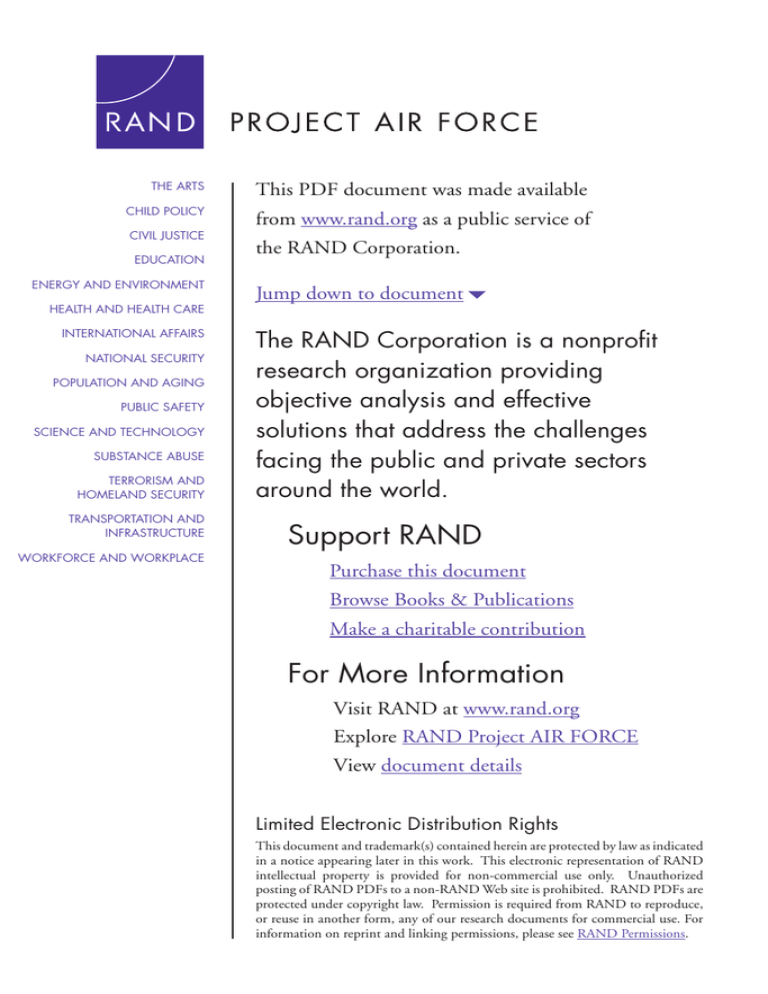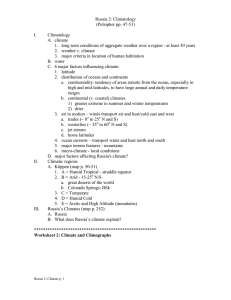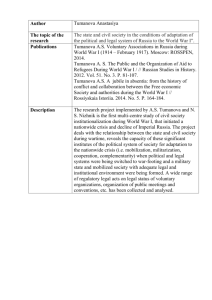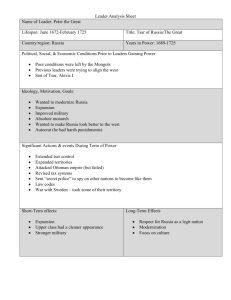6 The RAND Corporation is a nonprofit from
advertisement

THE ARTS This PDF document was made available CHILD POLICY from www.rand.org as a public service of CIVIL JUSTICE EDUCATION ENERGY AND ENVIRONMENT HEALTH AND HEALTH CARE INTERNATIONAL AFFAIRS NATIONAL SECURITY POPULATION AND AGING PUBLIC SAFETY SCIENCE AND TECHNOLOGY SUBSTANCE ABUSE TERRORISM AND HOMELAND SECURITY TRANSPORTATION AND INFRASTRUCTURE WORKFORCE AND WORKPLACE the RAND Corporation. Jump down to document6 The RAND Corporation is a nonprofit research organization providing objective analysis and effective solutions that address the challenges facing the public and private sectors around the world. Support RAND Purchase this document Browse Books & Publications Make a charitable contribution For More Information Visit RAND at www.rand.org Explore RAND Project AIR FORCE View document details Limited Electronic Distribution Rights This document and trademark(s) contained herein are protected by law as indicated in a notice appearing later in this work. This electronic representation of RAND intellectual property is provided for non-commercial use only. Unauthorized posting of RAND PDFs to a non-RAND Web site is prohibited. RAND PDFs are protected under copyright law. Permission is required from RAND to reproduce, or reuse in another form, any of our research documents for commercial use. For information on reprint and linking permissions, please see RAND Permissions. This product is part of the RAND Corporation monograph series. RAND monographs present major research findings that address the challenges facing the public and private sectors. All RAND monographs undergo rigorous peer review to ensure high standards for research quality and objectivity. Russian Foreign Policy Sources and Implications Olga Oliker Keith Crane Lowell H. Schwartz Catherine Yusupov Prepared for the United States Air Force Approved for public release; distribution unlimited PR OJ ECT AI R FORC E The research described in this report was sponsored by the United States Air Force under Contract FA7014-06-C-0001. Further information may be obtained from the Strategic Planning Division, Directorate of Plans, Hq USAF. Library of Congress Cataloging-in-Publication Data Russian foreign policy : sources and implications / Olga Oliker ... [et al.]. p. cm. Includes bibliographical references. ISBN 978-0-8330-4607-9 (pbk. : alk. paper) 1. Russia (Federation)—Foreign relations. 2. Russia (Federation)—Strategic aspects. 3. Globalization—Political aspects—Russia (Federation) 4. Russia (Federation—Politics and government—21st century. 5. Russia (Federation)— Foreign relations—United States. 6. United States—Foreign relations—Russia (Federation) I. Oliker, Olga. DK293.R8726 2009 327.47—dc22 2009006826 The RAND Corporation is a nonprofit research organization providing objective analysis and effective solutions that address the challenges facing the public and private sectors around the world. R AND’s publications do not necessarily reflect the opinions of its research clients and sponsors. R® is a registered trademark. Cover design by Eileen La Russo. (Photographs, clockwise from top: AP Images/Sergey Ponomarev; AP Images/Misha Japaridze; AP Images/Dmitry Lovetsky.) © Copyright 2009 RAND Corporation All rights reserved. No part of this book may be reproduced in any form by any electronic or mechanical means (including photocopying, recording, or information storage and retrieval) without permission in writing from RAND. Published 2009 by the RAND Corporation 1776 Main Street, P.O. Box 2138, Santa Monica, CA 90407-2138 1200 South Hayes Street, Arlington, VA 22202-5050 4570 Fifth Avenue, Suite 600, Pittsburgh, PA 15213-2665 RAND URL: http://www.rand.org To order RAND documents or to obtain additional information, contact Distribution Services: Telephone: (310) 451-7002; Fax: (310) 451-6915; Email: order@rand.org Summary To any time-traveling student of the Soviet Union or any Russia watcher of the 1990s, today’s Russia would be unrecognizable. The Russia that has reemerged as a foreign policy challenge for the United States today is significantly different from the Russia of the recent past—it is wealthier, more stable, increasingly less democratic, and more assertive globally. If U.S. policymakers hope to work with Russia on key foreign and security policy goals, they must be aware of how these goals do or do not align with Russia’s own interests. If they would like to see closer alignment between Russia’s choices and U.S. priorities, they need to understand the basis of Moscow’s foreign and security policy decisions, how Russian foreign policy goals may evolve, and how decisions are made in Russia. If they hope to influence Russian policies, whether through sticks or through carrots, they must know what Russian responses to such incentives will be. This knowledge can help explain where cooperation is and is not possible and where moreconfrontational postures may or may not be of value. This monograph analyzes the domestic and economic sources of Russian foreign and security policies. It then fleshes out Russian foreign and security policy interests, goals, and approaches. It concludes with an assessment of how Russia’s foreign and security policies and capabilities may affect the United States and the U.S. Air Force. xi xii Russian Foreign Policy: Sources and Implications Domestic Issues Domestic political measures put in place during Putin’s presidency have changed how the Russian government functions and how it rules. The elimination of elections for regional governors and the upper house of parliament and increasing government intervention in national elections for the State Duma and the presidency have diminished the government’s accountability to Russian citizens. Whether the hypercentralism of the Kremlin under Putin will mellow as Russia’s new president, Dmitri Medvedev, finds his feet is unclear. At present, Putin, now prime minister, remains very much in charge. Moreover, however the distribution of power evolves, the new Russian government is unlikely to diverge much from the current domestic political trajectory. Decisionmaking is likely to remain opaque and will be shaped, in large part, by competition among the various interest groups in power. (See pp. 9–28.) Popular opposition to the new government will remain weak. Not only have civil liberties been limited in the last few years, but there is little public appetite for what little dissent survives. The vast majority of Russians see the current state of affairs as a substantial improvement over the Russia of the 1990s, and most take pride in the Russian state for restoring Russia as an independent power. (See pp. 18–21, 42.) Population change and ethnic conflict are potential sources of domestic instability in Russia. As its population contracts, Russia may be forced to consider trade-offs in spending on health care, pensions, education, infrastructure, and security. Immigration may offset the decline in the Russian workforce, but most migrants are not ethnic Russians. Rather, they come from Russia’s southern periphery at a time when the share of ethnic Muslims in the total population is rising overall. The Kremlin’s failure to crack down on patriotic-nationalistic and even xenophobic activities exacerbates ethnic tensions. Indeed, Russia’s largest domestic security threat is the increasing violence in its economically underdeveloped and predominantly Muslim North Caucasus. (See pp. 28–41.) Summary xiii The Economy Following the collapse of the ruble in 1998, the Russian economy grew at an average annual rate of 6.7 percent through 2007. The ability of Russian consumers to purchase imported consumer goods has grown even more rapidly: Annual gross domestic product (GDP) growth in dollar terms averaged 26 percent over this period as the ruble strengthened against the dollar. Underneath the glitz of the oil and gas economy, economic development has followed patterns seen in other transition economies. Telecommunications, restaurants, retailing and wholesaling, and tourism grew rapidly. Banking boomed. It is these sectors— not oil and gas—that have been driving growth. Since 1998, increases in the dollar value of oil and gas exports may have contributed perhaps one percentage point to Russia’s average annual GDP growth rate. (See pp. 44–55.) However, Russia’s very rapid rates of growth in dollar GDP and incomes have come to an end. Even absent the economic crisis that hit Russia and much of the world in the third quarter of 2008, growth was poised to slow. The bounce back from the depths of the recession of the 1990s is over. The ruble depreciated in the fall of 2008 and is unlikely to appreciate rapidly in coming years. The extent to which growth slows will depend on whether the Russian government becomes more efficient, effective, and accountable and less corrupt. Even as growth moderates, however, Russia is poised to become one of the four largest economies in Europe by 2025. Incomes will continue to grow across the country, and the middle class will expand. Slower growth could nevertheless have political repercussions, including a decline in the popularity of the Medvedev-Putin government, less (or more) Russian hubris in relations with the West, and slower growth in Russian defense spending. (See pp. 55–60.) Meanwhile, the boom made it possible for the country to spend more, including on defense. Overall Russian defense spending was $32 billion in 2007, an amount equal to 2.6 percent of GDP.1 Spend1 Unless otherwise noted or clearly used in the context of a different (and indicated) period, currency is expressed in summer of calendar year 2008 terms. xiv Russian Foreign Policy: Sources and Implications ing on internal security (i.e., police, the Federal Security Service, and Ministry of the Interior troops) was even higher than that on defense. Indeed, spending on internal security has grown very rapidly—more rapidly than defense spending (which has not kept pace with economic growth). Much of Russia’s defense budget has been devoted to personnel costs, decommissioning programs, and military transformation. (See pp. 61–72.) Replacement of military hardware remains painfully slow. Although procurement (a small portion of the defense budget) is growing, Russia’s defense industry relies on arms exports to stay in business. Russia is one of the world’s largest arms exporters, although it trails the United States. China and India are its most important customers. (See pp. 72–82.) Russia could spend far more on defense than it currently does. Russian policymakers appear to have made a conscious decision to moderate growth in defense spending because of doubts about whether a bigger budget would be spent wisely. And while the Russian government has expressed the intent to spend more on defense in the future, it is not clear how feasible this will be in light of current economic constraints. (See pp. 69–72.) Foreign Policy Russia’s current foreign policy is focused on bolstering Russia’s prestige, supporting economic recovery and growth, and more effectively demonstrating power to keep Russia secure and able to pursue its policy goals. Although no enemies are poised to attack or threaten the country militarily, Russia’s leaders remain concerned about the country’s long-term safety. They worry that the current security situation will not last, just as they worry about a reversal of domestic stability and economic growth. They believe that Russia must build and retain its prestige now to ensure that it can defend its interests into the future (see pp. 83–93). As the Russian government seeks to enlarge its influence internationally, it finds those actions and policies of other states that might Summary xv limit Russia’s influence threatening. This is particularly true of the actions and policies of the countries on Russia’s periphery, where Russia’s influence, although not as extensive as Moscow might wish, is still strongest and where Russia sees some of the most immediate threats to its security. Moscow’s worries have long focused on the possibility that political instability in a neighboring country will involve Russia in violent unrest. Russia also fears that political change in those countries is a harbinger of instability to come within its own borders. Moscow’s willingness to take action to defend its influence in the region in light of these concerns was clearly demonstrated in the conflict between Russia and Georgia in August 2008. (See pp. 93–104.) Russian foreign policy priorities are also linked to its trade ties. In this context, the “Near Abroad” is important (see p. 94), but Europe is crucial.2 Although the Russian government has rejected many aspects of the European democratic model, Russian leaders and Russians still see themselves to a large extent as European. Because relations with the European Union (EU) have often been tense in recent years, Russia has focused its efforts on building bilateral ties with key countries, perhaps most successfully with Germany, and, outside the EU, with Turkey (see pp. 105–113). Russia’s efforts to turn itself into a respected “great power” have been more successful in some cases than others. Attempts to use supplies of natural gas and oil as a foreign policy lever in particular countries, even when those countries depend almost exclusively on Russia, have tended to backfire, as exemplified by Russian relations with Georgia and Ukraine. Moreover, rhetoric invoking the energy lever and cutoff of natural gas has worried Russia’s main European customers. These buyers are as important to Russia as Russia is as a supplier to Ukraine. Moscow’s willingness to use military force against Georgia in August 2008 has heightened tensions between Russia and many of its crucial partners as well, although the conflict has also demonstrated 2 Many Russians refer to the other states that emerged from the collapse of the Soviet Union as the “Near Abroad.” Because this monograph focuses on Russia’s views of the world and its foreign policy, we will use this terminology. We intend no political commentary by its use. xvi Russian Foreign Policy: Sources and Implications clearly that Russia is not likely to be swayed by diplomatic pressure and that it now feels it has sufficient prestige to defend and define its interests as it feels appropriate. (See pp. 95–102, 107, 110.) Russia’s focus on enhancing its international prestige and building economic relations has led it to become more involved in Asia and the Middle East. China is a key partner despite residual distrust on both sides, but other aspects of Russia’s Asia policy remain underdeveloped. In the Middle East, Russia has played an important role in relation to efforts to curtail Iran’s nuclear weapons program, and Moscow seeks a seat at the table on other key issues. This is, of course, in line with its overall global ambitions. (See pp. 113–122.) Russia’s relations with the United States have become rockier in recent years, in great part because the Russian government feels that U.S. policies undercut Russia’s prestige and power. U.S. criticism of Russia’s domestic policies, U.S. plans for missile defense, and U.S. efforts to spread democracy to countries on Russia’s borders have led Russian leaders to conclude that the United States has been acting contrary to Russia’s interests. From Moscow’s point of view, the Orange Revolution in Ukraine and the Rose Revolution in Georgia were not popular responses to contested elections but coups, precipitated by Western meddling, that replaced the previous governments with pro-Western ones. These “coups” are seen as part of a Western, and particularly U.S., effort to undermine Russian influence in states near Russia and change the government of Russia itself. Perceptions of U.S. support for Georgia during the August 2008 conflict and what was seen in Russia as biased Western reporting on the crisis have further fed distrust and hostility toward the United States among Russians. Similarly, Russia’s actions during that crisis have led many in the United States to distrust and blame Russia. (See pp. 126–131.) Although the United States and Russia share some common interests and goals, many of these common issues (especially defeating transnational threats) are more important to Washington than to Moscow. Russia enhances its prestige by working with the United States on these issues, but there is also much to be gained, at home and abroad, from standing up to Washington, for instance by espousing Summary xvii policies of nonintervention in other countries’ domestic affairs. (See pp. 122–126, 130–131.) Security Policy Russia appears to be focused on building a strong internal security apparatus and the military capacity to win small local wars. It retains its nuclear arsenal in part to respond to greater threats. This focus reflects the most likely dangers Russia faces: low-level conflicts within the country and small-scale actions nearby (as in Georgia). It also mirrors Russian leaders’ fear of dissent and opposition. As noted, in recent years, internal security forces have been getting an ever-larger share of the budget. (See pp. 143–145.) Russia’s armed forces today fall below the standards Russia might desire. Military technology receives some investment, but deployment of new systems lags tremendously. As part of a broad reform effort, the Russian Ministry of Defense is transforming the army from a predominantly conscripted force to one staffed by professional volunteer soldiers (with a goal of recruiting most of them from the conscript pool). Because the number of 18-year-old males in Russia will halve over the next decade, and given Russia’s plans to winnow its oversized officer corps, Russia will experience great difficulty in maintaining the force of 1 million people that its leaders have said the country requires. (See pp. 145–158.) Larger defense expenditures are evident in the Russian Air Force’s increased training and flying time and in the increased amount of money available for parts and maintenance. The recent resumption of Bear-H bomber flights in the Atlantic and Pacific theaters is one consequence of these changes. Procurement is also rising throughout the defense sector, but new aircraft, ships, and air defense systems are being added slowly. (See pp. 158–162.) The modernization of Russia’s nuclear forces is also proceeding slowly. As its core missile force ages and degrades and as the United States develops ballistic-missile defenses, the Russian government is growing increasingly concerned about the capacity of Russia’s nuclear xviii Russian Foreign Policy: Sources and Implications force to effectively deter the United States. For these reasons, there will be many advantages to the Russian government negotiating a followon agreement to the Strategic Arms Reduction Treaty (START) I to ensure continued numerical parity with the United States. In this context, Russia may well seek to maintain the intrusive START verification mechanisms that have given Moscow confidence that Washington is abiding by its arms control commitments. (See pp. 162–174.) Implications for the United States and the U.S. Air Force Russia’s higher confidence will continue to create challenges for U.S. policymakers. Although there is no real threat of armed conflict between Russia and the United States, poor relations will make it more difficult for the United States to achieve its global foreign policy goals. As the Georgia crisis showed, the two countries’ disagreements on a variety of foreign policy priorities and approaches are in danger of spiraling into hostility. It also showed that the United States currently holds little leverage over Russian policy. Only a few of Washington’s mechanisms for “punishing” Moscow can avoid prompting Russia to hit back in ways that are more harmful to the United States. A hostile Russia would create problems for the United States in Europe, the Middle East, and Asia and with U.S. allies and enemies. A Russia unwilling to cooperate on denying Iran and North Korea nuclear weapons could derail efforts to halt proliferation. If Russia refuses to cooperate on fighting transnational threats, the United States will find it much more difficult to defang these threats. Poor relations with Russia would also make it even more difficult for the United States to sway Russia toward more-democratic domestic policies and more-congenial foreign policies. (See pp. 177–180.) The U.S. goal must therefore be to improve relations with Russia and build on shared views and shared interests, rather than to seek to utilize coercive mechanisms that can easily backfire. Although this is a challenging proposition, there are steps that the United States can take. For example, the United States may be able to improve relations with Russia by ceasing to promote pipeline routes that circumvent Russia. Summary xix It should focus instead on what is most viable economically, including routes through Russia as well as around it (see pp. 187–188). The United States can also use its relationships with Russia and Russian neighbors to encourage all of these states to develop cooperative and healthy relationships with one another (see pp. 184–185). The United States would also be well-served by efforts to coordinate policy toward Russia with its European allies and by working with Russia to the extent possible in the European context (see pp. 186–187). Another key policy shift would be to vigorously pursue new arms control agreements and to take a more transparent approach to missile defense, focusing on consultations with Russia as plans and approaches are developed (see pp. 188–189). This would mean being open to a START I follow-on treaty and to new discussions about the Treaty on Conventional Armed Forces in Europe, the Intermediate-Range Nuclear Force Treaty, missile defense agreements, and other areas (see pp. 189–190). The United States should take at face value Russia’s expressed concerns about missile defense, which stem at least in part from genuine security worries, and work to alleviate those worries through consultations and negotiations. These discussions and negotiations could be useful in and of themselves by ensuring, and visibly so, that the United States takes Russia’s strategic interests seriously. Furthermore, they could lead to a new arms control framework between the two countries, thereby limiting the proliferation of dangerous weapons and making the world safer (see pp. 188–190). Consistent, high-level consultative mechanisms like the GoreChornomyrdin Commission of the 1990s could improve relations and generate progress on a number of issues, including those described in the previous paragraph. By raising disagreements at such a high level, these consultations would assuredly result in follow-on action. Even if problems could not be resolved through consultation, the mechanism itself could help each state better understand the other’s position and keep disagreement from spiraling (see pp. 192–193). Military contacts, particularly high-level visits, could serve similar functions at all levels of the Russo-U.S. security relationship (see pp. 190–192). Global initiatives, such as economic development in poorer countries, coordinated responses to the global economic situation, and climate change, are xx Russian Foreign Policy: Sources and Implications becoming more important to Russia and thus are also areas of potential cooperation (see p. 192). “Graduating” Russia from the Jackson-Vanik Amendment provisions (the requirements of which it has long ago met) and easing visa requirements so that more Russians are able to visit the United States would build trust (see p. 193). Although relations with Russia will be difficult for the foreseeable future, these policy changes could lay the groundwork for progress. If they do not, the United States must also be prepared to deal with a recalcitrant Russia. Indeed, even in the optimistic case of general cooperation between the two states, the United States and Russia will continue to disagree on a wide range of key issues. If relations between the two states go downhill, one of the priorities of U.S. policy will have to be finding ways of keeping poor relations with Russia from turning into adversarial ones. (See pp. 194–196.) The U.S. Department of Defense and the U.S. Air Force have important roles to play in the effort to improve ties, in thinking about how to manage relations with an unfriendly Russia, and in simply working with a Russia that sometimes agrees with U.S. goals and sometimes does not. Military contacts and arms control are key to the overall relationship, as noted above, and the Air Force has been and will continue to be a leading organization in this realm. However, the Air Force, like the United States as a whole, cannot assume that Russia, or any other state, can always be talked around to the U.S. point of view. Accordingly, consistent and continuous contingency planning is required. The U.S. Air Force should be prepared, for example, for limits on U.S. access throughout the region. This is one of the challenges that a more independent, strong, and forceful Russia will present to U.S. foreign policy goals throughout the world. (See pp. 183–184, 188, 192, 195–196.)







